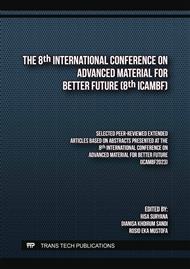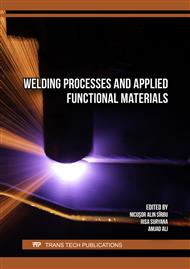[1]
Th. A. Singh, A. Sharma, N. Tejwan, N. Ghosh, J. Das, P.C. Sil, A state of the art review on the synthesis, antibacterial, antioxidant, antidiabetic and tissue regeneration activities of zinc oxide nanoparticles, Adv. Colloid Interface Sci. 295 (2021) 102495.
DOI: 10.1016/j.cis.2021.102495
Google Scholar
[2]
S. Tavakoli, M. Kharaziha, S. Nemati, Polydopamine coated ZnO rod-shaped nanoparticles with noticeable biocompatibility, hemostatic and antibacterial activity, Nano-Struct. Nano-Objects, 25 (2021) 100639.
DOI: 10.1016/j.nanoso.2020.100639
Google Scholar
[3]
E.Y. Shaba, J.O. Jacob, J.O. Tijani, M.A.T. Suleiman, A critical review of synthesis parameters affecting the properties of zinc oxide nanoparticle and its application in wastewater treatment, Appl. Water Sci. 11 (2021) 48.
DOI: 10.1007/s13201-021-01370-z
Google Scholar
[4]
B. Abebe, E.A. Zereffa, A. Tadesse, H.C.A. Murthy, A Review on Enhancing the Antibacterial Activity of ZnO: Mechanisms and Microscopic Investigation, Nanoscale Res. Lett. 15 (2020) 190.
DOI: 10.1186/s11671-020-03418-6
Google Scholar
[5]
D.Yadav, N. Tyagi, H. Yadav, A. James, N. Sareen, M. Kapoor, K. Kumar, Y. Kataria, K. Singhal, Effect of various morphologies and dopants on piezoelectric and detection properties of ZnO at the nanoscale: a review, J. Mater. Sci. 58 (2023) 10576.
DOI: 10.1007/s10853-023-08680-4
Google Scholar
[6]
L.M. Huong, N.M. Dat, N.T.H. Nam, N.D. Hai, L.T. Tai, H. An, C.Q. Cong, N. T. Dat, N. H. Vu, D.T. C. Minh, T.D. Dat, P.N. P. Hung, N.H. Hieu, An overall assessment of the pathway procedures, analytical approaches, and potentially essential applications of zinc oxide nanostructured materials, Inorg. Chem. Commun. 157 (2023) 111430.
DOI: 10.1016/j.inoche.2023.111430
Google Scholar
[7]
J. Wang, R. Chen, L. Xiang, S. Komarneni, Synthesis, properties and applications of ZnO nanomaterials with oxygen vacancies: A review, Ceram. Int. 44 (2018) 7357.
DOI: 10.1016/j.ceramint.2018.02.013
Google Scholar
[8]
J. Ungula, B.F. Dejene, H.C. Swart, Effect of pH on the structural, optical, and morphological properties of Ga-doped ZnO nanoparticles by reflux precipitation method, Physica B 535 (2018) 251.
DOI: 10.1016/j.physb.2017.07.052
Google Scholar
[9]
M. Anandan, S. Dinesh, N. Krishnakumar, K. Balamurugan, Tuning the crystalline size of template free hexagonal ZnO nanoparticles via precipitation synthesis towards enhanced photocatalytic performance, J. Mater. Sci.: Mater. Electron. 28 (2017) 2574.
DOI: 10.1007/s10854-016-5833-2
Google Scholar
[10]
K. Akhtar, N. Zubair, S. Ikram, Z.U. Khan, H. Khalid, Synthesis and characterization of ZnO nanostructures with varying morphology, Bull. Mater. Sci., 40(3) (2017) 459.
DOI: 10.1007/s12034-017-1386-0
Google Scholar
[11]
S. Suwanboona, P. Amornpitoksuk, P. Bangrak, C. Randorn, Physical and chemical properties of multifunctional ZnO nanostructures prepared by precipitation and hydrothermal methods , Ceram. Int. 40(2014) 975.
DOI: 10.1016/j.ceramint.2013.06.094
Google Scholar
[12]
S.G. Sanches, J.H. Flores, M.I. Pais da Silva, Influence of aging time on the microstructural characteristics of a Cu/ZnO-based catalyst prepared by homogeneous precipitation for use in methanol steam reforming, Reac. Kinet. Mech. Cat. 121 (2017) 473.
DOI: 10.1007/s11144-017-1161-7
Google Scholar
[13]
S. Sheikhi, M. Aliannezhadia, F.S. Tehrani, Effect of precursor material, pH, and aging on ZnO nanoparticles synthesized by one-step sol–gel method for photodynamic and photocatalytic applications, Eur. Phys. J. Plus, 137 (2022) 60.
DOI: 10.1140/epjp/s13360-021-02252-8
Google Scholar
[14]
H. Aoji, H. Shiomi, Effects of aging conditions on the morphologies of ZnO particles synthesized under hydrothermal conditions from layered zinc hydroxide as a precursor derived from zinc acetate, J. Asian Ceram. Soc. 8(1) (2020) 81.
DOI: 10.1080/21870764.2019.1709692
Google Scholar
[15]
I. Nurhasanah, S. Rohmaniah, Y. Astuti, D.A. Kinasih, Efficient degradation of pharmaceutical drugs using cerium‑doped zinc oxide nanophotocatalysts synthesized via the sono‑precipitation route, Nanotechnol. Environ. Eng. 8 (2023) 899.
DOI: 10.1007/s41204-023-00340-x
Google Scholar
[16]
I. Cherif, Y. O. Dkhil, S. Smaoui, K. Elhadef, M. Ferhi, S. Ammar, X-Ray Diffraction Analysis by Modified Scherrer, Williamson–Hall and Size–Strain Plot Methods of ZnO Nanocrystals Synthesized by Oxalate Route: A Potential Antimicrobial Candidate Against Foodborne Pathogens, J. Clust. Sci. 34 (2023) 623.
DOI: 10.1007/s10876-022-02248-z
Google Scholar



